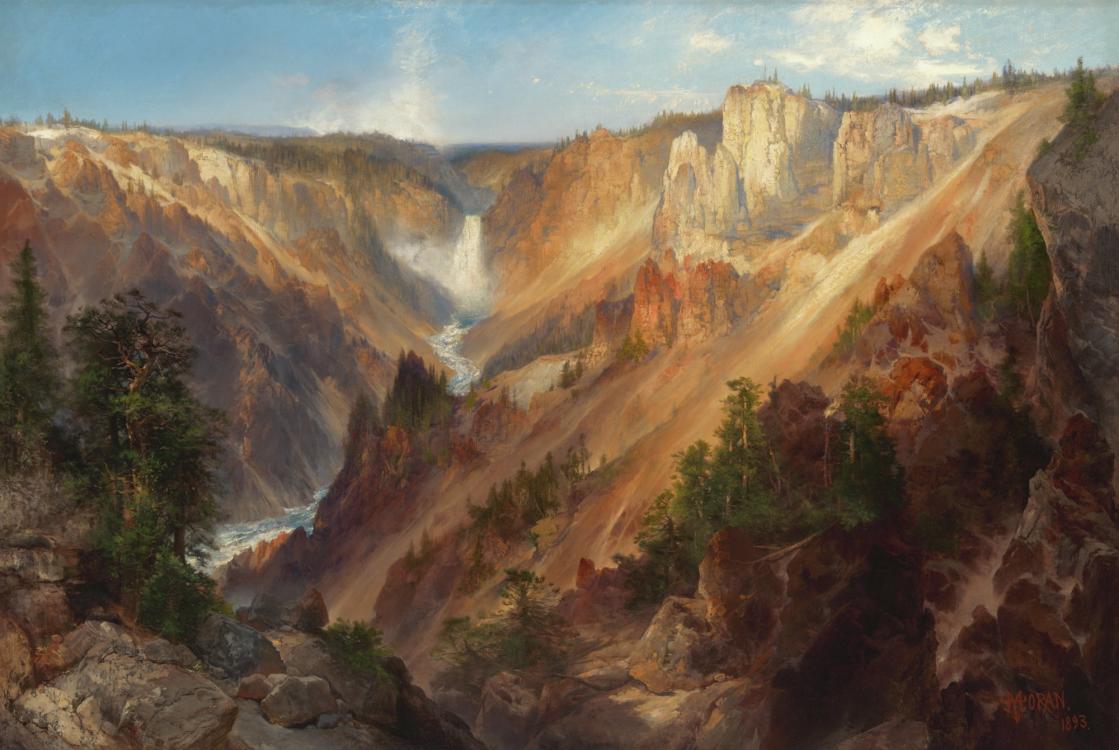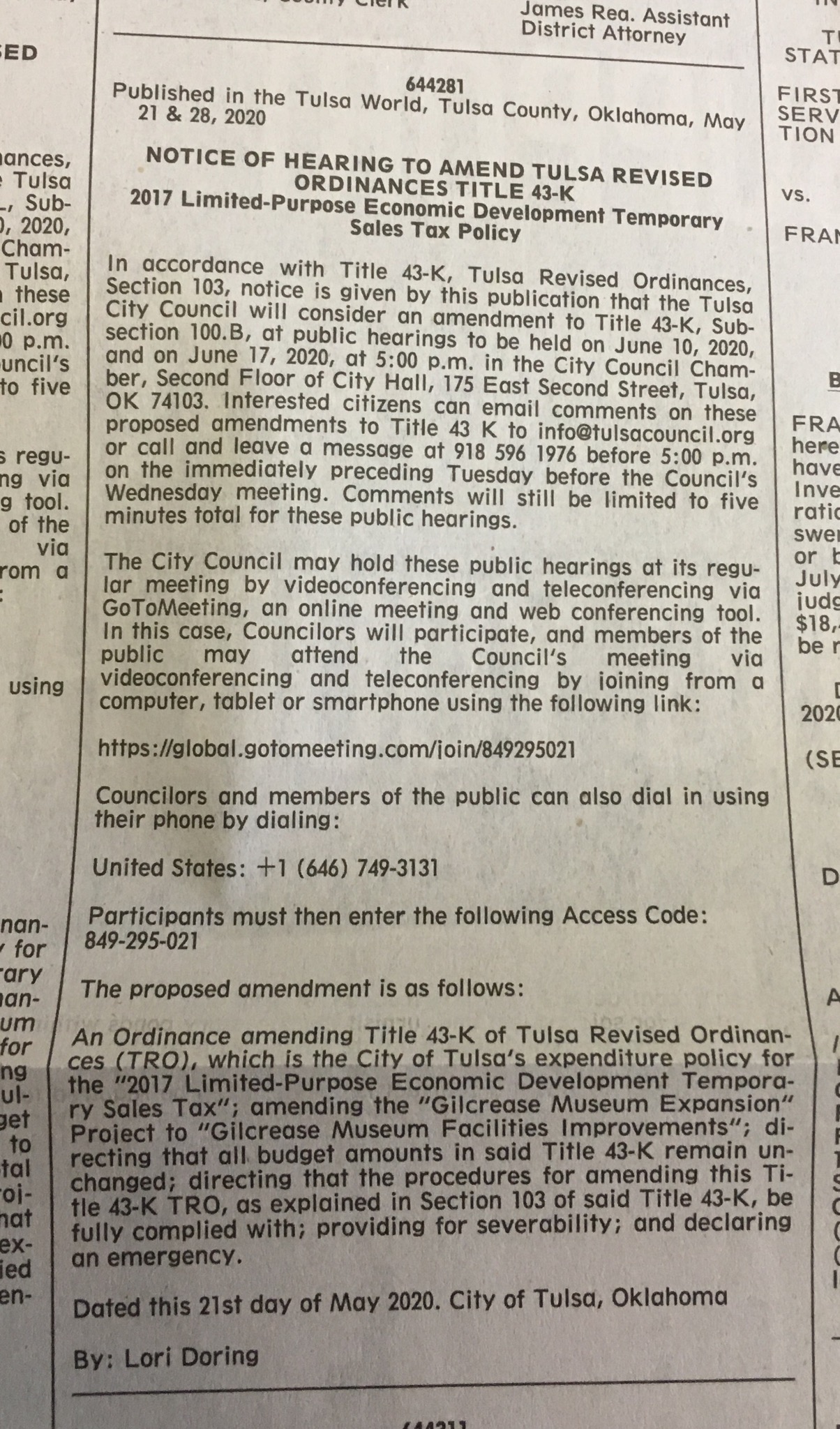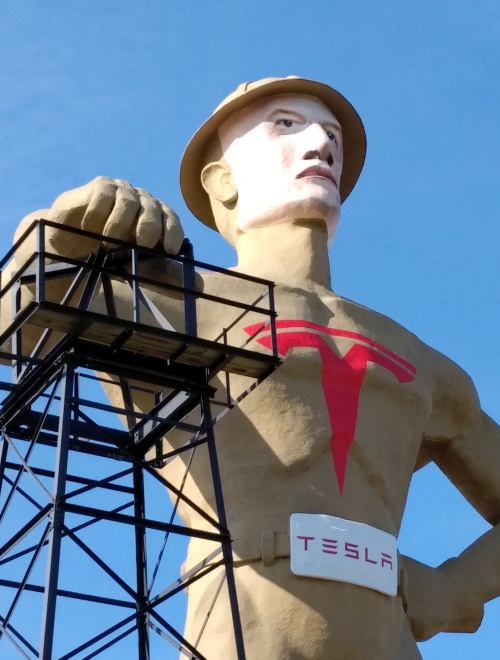Tulsa City Hall: May 2020 Archives
 Back at the beginning of March, we reported that Gilcrease Museum would not be renovated and expanded, as Tulsa voters were promised in April 2016, but would instead be demolished and rebuilt as a smaller facility, with the help of funding from the University of Tulsa and other donors.
Back at the beginning of March, we reported that Gilcrease Museum would not be renovated and expanded, as Tulsa voters were promised in April 2016, but would instead be demolished and rebuilt as a smaller facility, with the help of funding from the University of Tulsa and other donors.
The change is substantial enough that the new plans will not fit within the broad language of the "Brown Ordinance" adopted in advance of the April 2016 tax vote, so the provisions of the ordinance have been invoked and a legal notice has been published, announcing public hearings on June 10 and June 17, 2020, to consider an amendment to Title 43-K to change the name of the line item "Gilcrease Museum Expansion" to "Gilcrease Museum Facilities Improvements."

The "Brown Ordinance" is named in honor of former City Attorney Darven Brown. City of Tulsa capital improvements were traditionally financed by general obligation bond issues (repaid by property taxes) or revenue bond issues (repaid by, e.g., water and sewer customers, parking garage customers, airline passengers). In 1979, Mayor Jim Inhofe attempted to pass a one-cent sales tax to fund a backlog of capital improvement needs, but the vote failed, in part because a sales tax, once in effect, could be spent on anything, even operational costs, unlike a bond issue, which could only be spent on the named improvements. Brown came up with the idea of an ordinance which set out the specific projects to be funded and the amount allocated for each, provided for a Sales Tax Overview Committee to monitor spending, provided for a process to ensure sufficient public notice of proposed changes, and established penalties (including removal from office) for spending any of the money contrary to the ordinance. With the Brown Ordinance in place (and with the Zink Lake low-water dam removed from the package), the sales tax passed on Inhofe's second attempt in 1980. A Brown Ordinance has been enacted for each city capital improvements sales tax vote ever since.
Title 43-K is the Brown Ordinance attached to the 2016 Vision Tulsa tax. It was amended within a year that of its passage. The promise that the South Tulsa/Jenks low-water dam would be cancelled and its $64 million in funding reallocated if Tulsa and the Muscogee Creek Nation could not reach a partnership agreement by December 31, 2016, was nullified in February 2017 and replaced with a deadline at the end of this year. (The original proposed change was to a vague deadline of "within a reasonable time.") The ordinance was changed again in May 2019 to move all $3.6 million designated for OSU-Tulsa to increase the BMX World Headquarters funding from $15 million to $18.6 million.
I hope that Tulsans will register their objections to this proposal publicly through social media and with their city councilors. Tulsans voted for expansion of Gilcrease, not contraction, not relocation, and certainly not demolition of this historic facility. The proposed new language doesn't fit the announced plans: Total or near-total demolition can hardly be considered a "facilities improvement." This could be considered an attempt to deceive in the legal notice and could subject the councilors to lawsuits and removal from office if they go ahead with it. Tulsans should insist that their councilors approve an honest title for the line item: "Gilcrease Museum: Demolition and reconstruction as a smaller facility," and it is this title that should be published as a legal notice.
Tulsans should also insist that this change not move forward unless and until the City begins to disentangle our priceless Gilcrease collection from the troubled University of Tulsa. The City should terminate its management contract with TU, reject any contributions from the Kaiser System (the name given by Michael Mason to the network of organizations linked to the Obama-backing billionaire), and insist that the collection remain at the same site. Any additional money needed could be reallocated from the dam project that will likely never happen. Some of these stipulations could be written into the Brown Ordinance to ensure compliance.
RELATED: President Trump tweeted on Wednesday:
The Tulsa, Oklahoma area has been approved for a transportation loan from the @USDOT of up to $120M to help expand highway on the Gilcrease Expressway West Project. This will mean less congestion and faster routes to popular spots! @GovStitt
The loan will be to the Oklahoma Turnpike Authority, which will repay the loan from the tolls it will be collecting on the five-mile stretch of the west leg of the Gilcrease Expressway between the I-44/I-244 west junction and US 412 at 57th West Avenue.
 It's cringe-worthy. Some persons, apparently with the permission of the Tulsa County Public Facilities Authority, painted the Tesla logo on the chest of the Golden Driller, and painted the name Tesla on his belt buckle, over the word Tulsa. If that weren't bad enough, used some kind of wrap to cover the statue's face to turn it pale, almost white, to try match the appearance of Tesla chairman Elon Musk's pale, square face.
It's cringe-worthy. Some persons, apparently with the permission of the Tulsa County Public Facilities Authority, painted the Tesla logo on the chest of the Golden Driller, and painted the name Tesla on his belt buckle, over the word Tulsa. If that weren't bad enough, used some kind of wrap to cover the statue's face to turn it pale, almost white, to try match the appearance of Tesla chairman Elon Musk's pale, square face.
Images of this work began circulating on social media on Tuesday, May 19, 2020, and many people thought it was some kind of lame photo-manipulation meme. At 2 pm on Wednesday, Tulsa Mayor G. T. Bynum IV led an "unveiling" of the modified statue -- unveiling consisting of a big white sheet (twin size, if the Golden Driller had a bed) held by two cranes in front of the statue, then dropped on cue.
Meanwhile someone created a webpage called bigf***ingfield.com, urging Musk to locate his new "cybertruck gigafactory" in Tulsa.
While some Tulsans on social media applauded the effort, many more expressed emotions ranging from amusement to dismay at these gestures which were endorsed by our city's leaders, describing the promotions as cringe-inducing, pathetic, needy, and desperate. Some thought the Tesla logo on the Golden Driller was reasonable, but the Elon Musk mask was just creepy. (It reminded me of fictional TV celebrity Alan Partridge's visit to an obsessed fan's home.)
All this was triggered by a story in TechCrunch on May 15:
Tesla officials visited two sites in Tulsa, Oklahoma this week to search for a location for its future and fifth gigafactory that will produce its all-electric Cybertruck and Model Y crossover, a source familiar with the situation told TechCrunch.Company representatives also visited Austin. A final decision has not been made, but Austin and Tulsa are among the finalists, according to multiple sources. The AP also reported Tulsa and Austin as top picks for the gigafactory.
It was earlier last week that Musk, frustrated by CCP Bat Virus-related restrictions in Alameda County, California, threatened to move the Fremont factory and Tesla headquarters out of California. On May 9th, Musk tweeted:
Tesla is filing a lawsuit against Alameda County immediately. The unelected & ignorant "Interim Health Officer" of Alameda is acting contrary to the Governor, the President, our Constitutional freedoms & just plain common sense!Frankly, this is the final straw. Tesla will now move its HQ and future programs to Texas/Nevada immediately. If we even retain Fremont manufacturing activity at all, it will be dependen on how Tesla is treated in the future. Tesla is the last carmaker left in CA.
Neither Texas nor Nevada have an income tax, and Tesla already has a gigafactory east of Reno where batteries for its vehicles are manufactured.
I have the sneaking suspicion that rumors of Tulsa being considered were designed to frighten the City of Austin and the State of Texas into sweetening the deal. When a company comes to a vendor right before a deadline and asks for a quote, it's often an indication that the company has already selected another vendor for the work, but needs a competing quote to satisfy internal policies or as leverage to improve the preferred vendor's bid. The result is a lot of activity and expense with little realistic hope of a good result.
Several people have noticed the interesting timing of City of Tulsa's spat with Navistar IC Bus, the bus manufacturer that operates in Air Force Plant No. 3. The plant, used for building bombers during World War II, has a footprint of about 1.3 million square feet. Tesla's Nevada factory has a footprint of 1.9 million sq. ft.
When I was a young man, I learned the hard way that, contrary to TV shows and movies and the poetry we read in English class, wearing one's heart on one's sleeve, declaring one's undying and complete devotion to one's beloved, is not an effective courtship strategy. The object of such attention is apt to respond with indifference, pity, or revulsion. Those who went about their lives with confidence and purpose, without regard to the impression they made on the opposite sex, were far more successful with the opposite sex.
In 1908, a five-car train carrying 113 Tulsans, including a brass band, went around the northeastern and midwestern US on a two-week excursion to promote the city to potential businesses and residents. The Booster Train's itinerary included St. Louis, Indianapolis, Louisville, Cincinnati, Washington, New York, Philadelphia, Pittsburgh, Cleveland, Chicago, Des Moines, and Kansas City. They were welcomed heartily everywhere they went. One participant, C. W. Deming, told the Tulsa Democrat upon their arrival home:
We arrived on fairly good time in all cities, unloaded ourselves, 113 strong, lined up behind the band and marched through the streets. Six or eight of us would walk along the sidewalks with an arm load of the special issue of the Booster [a daily paper printed on board the train] for every town we visited, throwing them in doors, mingled with the people and handed them papers out right and left through the large crowds which blocked the sidewalks and street crossings.
The Tulsa Boosters didn't go pleading with businesses to move to the city or trying to bribe them with incentive payments. They didn't focus flattery on Eastern kingpins in hopes of winning their investment. The Tulsa Boosters projected confidence and pride in their city, which had grown in eight years from a population of 1,313 to about 16,000. They touted the availability of energy for manufacturing. They brought an exhibition car to demonstrate the natural resources of the city and its environs. From page 3 of the April 20, 1908, New York Sun:
Out of alfalfa growing knee high in the exhibition car of their own private train..., more than 100 representative citizens of Tulsa, the greatest town of Oklahoma -- ask them! -- stepped upon the soil of Jersey and walked as quickly as possible to the ferryboat which was to give them an Easter morning glimpse of New York....Alfalfa isn't the only thing growing in the car of the special train over in Jersey City. Whole branches of cherry trees are there, with cherries as big as they ought to be in April growing on them, branches cut from the trees a week ago whose fruit shows, as the Tulsans say, that the cherries left on the trees in Tulsa will be ripe and waiting for them when they reach home again in ten days more. Besides these there are samples of all the woods of the Tulsa region of Oklahoma and samples of the limestone, the shale and the other natural ingredients of Tulsan success and prosperity, and also photographs showing what a town situated on ten railroads can do in the way of growing in six years of lifetime. ...
The excursion is really a big one for Tulsa, more than a hundred of her business and professional men leaving their occupations and paying their share of a $25,000 or $30,000 trip of 3,500 miles for the purpose of bringing Tulsa to the world's notice and the hope of bringing the world to Tulsa. Tulsa buys of New York merchants, to be sure, but she buys mainly through St. Louis, Chicago and Kansas City branches or houses. Her business men feel that they might do better for themselves and better for New York also if they could deal direct with the metropolis.
This they desire to bring about to some degree if they can get acquainted to-day with Broadway -- the business part of Broadway. They also want to tell people that Tulsa can furnish 200,000,000 feet of natural gas every twenty-four hours at two cents per foot [per thousand feet, according to other stories] for manufacturing concerns which might find it convenient to establish there branches to take care of the great Southwestern trade.
It would be a great thing for Tulsa to gain a few thousand manufacturing jobs, but pathetic, needy, creepy gestures will not impress those who are selecting the site. So many of the people I've seen expressing enthusiasm for the Elon Musk mask on the Golden Driller or the vulgarly named website are also among those who frequently express shame and embarrassment about Oklahoma and our state's church-going ways. They seem to hope that Musk and company will come here to transform Tulsa into a progressive paradise, rather than to benefit from our conservative character. Perhaps that makes it hard for them simply to be dignified and confident in what our city and state has to offer.
Tulsa's leaders should emulate their predecessors from a century ago: Make Tulsa the best Tulsa we can be (not San Francisco or New York City or even Austin) and be confident enough in what we have to offer that we simply let the world know what they can find here, rather than grovelling in hopes of becoming something different.
MORE: The American Oil & Gas Historical Society has an article on the evolution of the Golden Driller, including the earlier, very different 1953 and 1959 versions for the International Petroleum Exposition (IPE). The present-day driller was built in 1966 alongside the permanent 9-acre IPE Building. This Land Press published the story of the permanent Golden Driller and its Greek immigrant designer, George Hondronastas. In dire shape, with a hole in his boot, the Driller escaped the wrecking ball and was refurbished in 1979.
Tulsa Gal, Atlas Obscura, Roadside America, and Wikipedia all have articles on the statue. Mental Floss ties the story of the Golden Driller into Tulsa's history as Oil Capital of the World. The Tulsa World has the story of Spooky, the cat who was rescued from the statue in 1976, at a time when the statue's skin was flimsier than it is now. Kent Schnetzler has posted a May 1966 photo of the Golden Driller, taken by his father, Robert Schnetzler, which shows the original, thinner shell of the statue, with the rebar grid clearly visible.
A scale replica of the Golden Driller stands in front of a 216 ft free-fall ride of the same name in Fraispertuis City amusement park in the historic province of Lorraine, in the northeast of France.